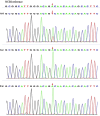Novel SETBP1 D874V adjacent to the degron causes canonical schinzel-giedion syndrome: a case report and review of the literature
- PMID: 38711130
- PMCID: PMC11071329
- DOI: 10.1186/s12887-024-04779-y
Novel SETBP1 D874V adjacent to the degron causes canonical schinzel-giedion syndrome: a case report and review of the literature
Abstract
Schinzel-Giedion syndrome (SGS) is a severe multisystem disorder characterized by distinctive facial features, profound intellectual disability, refractory epilepsy, cortical visual impairment, hearing loss, and various congenital anomalies. SGS is attributed to gain-of-function (GoF) variants in the SETBP1 gene, with reported variants causing canonical SGS located within a 12 bp hotspot region encoding SETBP1 residues aa868-871 (degron). Here, we describe a case of typical SGS caused by a novel heterozygous missense variant, D874V, adjacent to the degron. The female patient was diagnosed in the neonatal period and presented with characteristic facial phenotype (midface retraction, prominent forehead, and low-set ears), bilateral symmetrical talipes equinovarus, overlapping toes, and severe bilateral hydronephrosis accompanied by congenital heart disease, consistent with canonical SGS. This is the first report of a typical SGS caused by a, SETBP1 non-degron missense variant. This case expands the genetic spectrum of SGS and provides new insights into genotype-phenotype correlations.
Keywords: SETBP1; Hydronephrosis; Neonate; Schinzel-Giedion syndrome.
© 2024. The Author(s).
Conflict of interest statement
The authors declare no competing interests.
Figures




Similar articles
-
Overlapping SETBP1 gain-of-function mutations in Schinzel-Giedion syndrome and hematologic malignancies.PLoS Genet. 2017 Mar 27;13(3):e1006683. doi: 10.1371/journal.pgen.1006683. eCollection 2017 Mar. PLoS Genet. 2017. PMID: 28346496 Free PMC article.
-
A pathogenic variant in the SETBP1 hotspot results in a forme-fruste Schinzel-Giedion syndrome.Am J Med Genet A. 2020 Aug;182(8):1947-1951. doi: 10.1002/ajmg.a.61630. Epub 2020 May 22. Am J Med Genet A. 2020. PMID: 32445275
-
The recurrent SETBP1 c.2608G > A, p.(Gly870Ser) variant in a patient with Schinzel-Giedion syndrome: an illustrative case of the utility of whole exome sequencing in a critically ill neonate.Ital J Pediatr. 2020 May 27;46(1):74. doi: 10.1186/s13052-020-00839-y. Ital J Pediatr. 2020. PMID: 32460883 Free PMC article.
-
Schinzel-Giedion syndrome: a novel case, review and revised diagnostic criteria.J Genet. 2018 Mar;97(1):35-46. J Genet. 2018. PMID: 29666323 Review.
-
Depressing time: Waiting, melancholia, and the psychoanalytic practice of care.In: Kirtsoglou E, Simpson B, editors. The Time of Anthropology: Studies of Contemporary Chronopolitics. Abingdon: Routledge; 2020. Chapter 5. In: Kirtsoglou E, Simpson B, editors. The Time of Anthropology: Studies of Contemporary Chronopolitics. Abingdon: Routledge; 2020. Chapter 5. PMID: 36137063 Free Books & Documents. Review.
Cited by
-
Epigenetics in rare neurological diseases.Front Cell Dev Biol. 2024 Jul 23;12:1413248. doi: 10.3389/fcell.2024.1413248. eCollection 2024. Front Cell Dev Biol. 2024. PMID: 39108836 Free PMC article. Review.
References
-
- Acuna-Hidalgo R, Deriziotis P, Steehouwer M, Gilissen C, Graham SA, van Dam S, Hoover-Fong J, Telegrafi AB, Destree A, Smigiel R, et al. Overlapping SETBP1 gain-of-function mutations in Schinzel-Giedion syndrome and hematologic malignancies. PLoS Genet. 2017;13(3):e1006683. doi: 10.1371/journal.pgen.1006683. - DOI - PMC - PubMed
-
- Richards Sue, Nazneen A, Sherri B, Soma BDD, Grody Wayne G-F, Rehm Heidi W, L., ACMG Laboratory Quality Assurance Committee. Standards and guidelines for the interpretation of sequence variants: a joint consensus recommendation of the American College of Medical Genetics and Genomics and the Association for Molecular Pathology. Genet Med, 2015; 17(5), 405 – 24. 10.1038/gim.2015.30. - PMC - PubMed
Publication types
MeSH terms
Substances
Supplementary concepts
LinkOut - more resources
Full Text Sources

